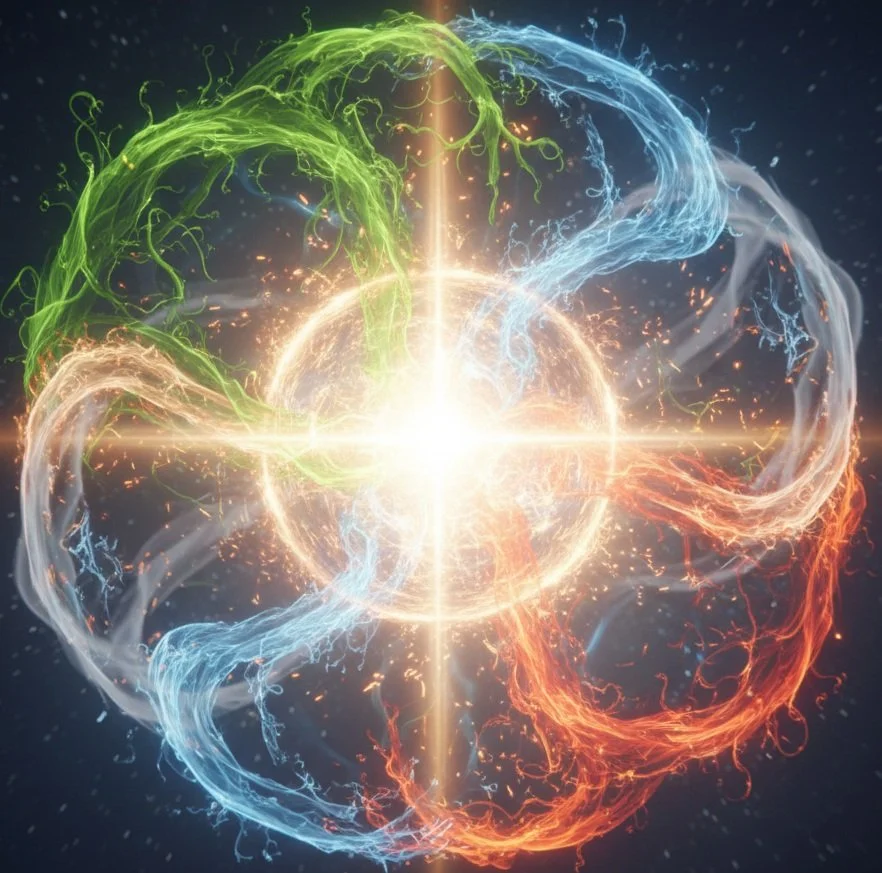Earth, Fire, Air, Water: The Ancient Map for Modern Systems
For most of my life, the world felt like a puzzle I hadn’t been given the box for.
I could memorize every detail of a conversation but still miss what people meant. I could sense patterns in tone, rhythm, silence, the hidden currents under language. But I didn't know what to do with them. Living with autism meant I noticed everything, but without a system to hold that information, everything felt like chaos.
So I started building one.
Over time, I began to see that people, relationships, and organizations all move through energetic patterns. Every room has a pulse, every conversation has a temperature, every team has a rhythm that reveals whether it’s in flow or friction. The same patterns kept repeating, no matter where I looked.
Eventually, I started thinking about these patterns as elements, not as personality qualifiers, exactly, but as states of energy within a system.
Earth. Fire. Air. Water.
The ancient world saw these not as opposites, but as forces in constant relationship. Modern psychology loves to classify, but I use this elemental lens not to reduce people, but to understand the energetic systems we all carry.
Why You Should Learn to Read the Elements
By breaking the complexity of human interaction down into four simple elements, you gain a reliable framework for identifying imbalance and knowing precisely where to apply energy to restore flow.
Understanding your elemental architecture helps you:
Stop Fixing People, Start Tending Systems: Instead of labelling someone as "difficult," you see them as having an overextended element (e.g., Fire is burning out, or Earth has become too rigid).
Decipher Friction: When two people short-circuit, you learn the elemental clash at play (e.g., Fast-moving Air is frustrating Steady Earth).
Find Your User Manual: You discover your own dominant elements, those that nourish you, what and how stresses deplete you, and how to operate at your best.
This logic isn't confined to your personal life; we can apply this same map to any group—your office, team, family, or social circles—to understand how energy moves through them and what balance looks like.
The Core Elements: States of Energy in a System
Earth: The Foundation
Earth energy holds. It creates stability and form.
You’ll feel it in people who: build structure and continuity, often quietly and without fanfare; steady others through reliability, patience, and presence.
When overextended: Earth energy hardens into control—too much holding, not enough adaptation. In systems, this looks like bureaucracy, stagnation, or fear of change. But in balance, Earth is what makes growth sustainable.
Fire: The Catalyst
Fire energy activates. It transforms inertia into momentum.
You’ll feel it in people who: ignite ideas, drive urgency, and push boundaries; speak in verbs (act, build, challenge, change).
When uncontained: Fire scorches, exhausting teams or burning through resources. But when it’s directed with care, Fire becomes the system’s heartbeat, the force that keeps evolution alive.
Air: The Current
Air energy connects. It moves ideas, language, and meaning between people.
You’ll feel it in people who: think fast, communicate fluidly, and link patterns across domains; translate complexity into clarity.
When overextended: Air dissipates—lots of motion, little landing. Systems dominated by Air get lost in meetings, memos, or theory. But when grounded, Air becomes flow, the cross-pollination that sparks innovation.
Water: The Integration
Water energy heals. It binds systems through empathy and emotion.
You’ll feel it in people who: sense undercurrents others miss (tension, fatigue, unspoken grief); Water moves with compassion, turning groups into communities.
When overextended: Water floods, taking on too much until boundaries dissolve. In balance, though, Water is what allows systems to regenerate—and stay human while they grow.
The Field of Awareness: Ether
Something beyond them all is what I think of as ether, the awareness that connects and integrates the rest.
Ether is the field that holds everything. It’s not a personality but a presence. You’ll feel it in moments when a group suddenly syncs, or when awareness expands beyond individual roles into shared understanding.
Ether thrives on stillness and space, reflection, integration, and in the pause before movement.
It’s what allows Earth, Fire, Air, and Water to coexist without collapsing into chaos.
Conclusion: Balancing the Ecosystem
Understanding your elemental architecture isn’t about self-typing—it’s about learning to read energy as information: how your nervous system, your work, and your relationships move through states of stability, activation, connection, and care.
Because we aren’t just one element. We are shifting architectures—fluid systems constantly seeking equilibrium.
When you learn to recognize the patterns, you stop asking “What’s wrong with me?” or “What’s wrong with them?”
You start asking: “What’s out of balance here, and how can I help it flow again?”
That’s when understanding becomes compassion.
And compassion—that’s what restores the system.
Which element are you learning to balance right now?
































For decades, I lived inside a storm I couldn’t name. A restless mind. A body always braced. A heart that felt heavier than it should. I blamed myself. I blamed circumstances. I worked harder, tried harder, forced myself into routines that never stuck. I spent years believing I was simply too much and not enough at the same time.
Then, a diagnosis reframed everything.